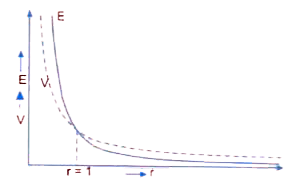Draw a plot showing the variation of (i) electric field E, and (ii) electric potential V with distance 'r' due to a point charge Q.
(i) Electric field E at a point situated at a distance r from a given point charge Q is given as :
E=14πε0.Qr2
(ii) The electric potential at a point varies as
V=14πε0.Qr
As a result, the graphical variation of E as well as V with r is as being shown in Fig. 
Similar Questions
Draw graph showing the variation of electronic field & electronic potential with distance 'r' due to point change.
View SolutionElectric field due to point charge
View SolutionShow on a plot the nature of variation of the (i) electric field (E), and (ii) potential (V) of a small electric dipole with the distance (r) of the field point from the centre of the dipole.
View SolutionThe electric field and the electric potential at a point are E and V respectively.
View SolutionGraphically represent the variation of electric potential and electric field due to point charge with respect to the distance from the point charge.
View SolutionDraw a plot showing variation of electric field with distance from the centre of a solid conducting sphere of radius R having a charge Q on its surface.
View SolutionShow on a plate the nature of variation of the (i) Electric field (ii) potenital (V), of a (small) electric dipole with the distance (r) of the filed point from the centre of the dipole.
View SolutionDraw a plot showing variation of electric field with distance from the centre of a solid conducting sphere of radius R, having of + Q on its surface.
View SolutionPlot a graph comparing the variation of potential ‘V’ and electric field ‘E’ due to a point charge ‘Q’ as a function of distance r from point charge
(ii) Find the ratio of the potential differences that must be applied across the parallel and the series combination of two identical capacitors so that the energy stored, in the two cases, becomes the same.
View Solution(a) Use Gauss's law to show that due to a uniformly charged spherical shell of radius R, the electric field at any point situated outside the shell at a distance r from its centre is equal to the electric field at the same point, when the entire charge on the shell were concentrated at its centre. Also plot the graph showing the variation of electric field with r, for r≤R and r≥R. (b) Two point charges of +1μC and +4μC are kept 30 cm apart. How far from the +1μC charge on the line joining the two charges, will the net electric field be zero ?
View Solution

